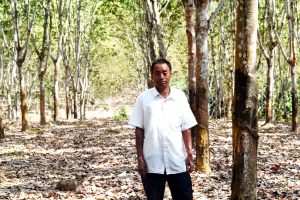High returns encouraging more farmers in ‘Land of Rubber’

Kohima, March 26 (EMN): Realising the adverse impact ‘jhum’ cultivation (slash-and-burn) to the ecosystem, farmers who have engaged the traditional system are slowly shifting to other more sustainable methods of agricultural practices such as plantation for livelihood.
Farmers from across Nagaland have started growing rubber and coffee on massive scales: they generate more income and require less labour compared to that required by traditional cultivations.
In Wokha district–declared ‘the land of plenty’–most families are now engaged in rubber plantation. During the year 2015, about 11, 943 growers took up rubber plantation in Wokha district alone. The number has increased to 15, 661 in 2016.
About 78 families from seven villages of Chudi, Pongidong, Sirika, M Baghty, Ralan, Yanthung Meriyan and Totsu are engaged in rubber tapping.
55 years old Renathung Humtsoe from Pongidong village has been into rubber plantation for the past 14 years. He spoke of his success in the cultivation recently.
In an area measuring one hectare, Humtsoe has 560 rubbers trees. He has started to reap the benefits from his rubber plants; his income increases yearly. During the previous year, he could harvest 2, 500 kilograms of rubber. The income generated from it comes to about 2,50,000 (two lakh and a fifty thousand).
Prior to taking up rubber plantation, Humtsoe, who has five children, was engaged in jhum cultivation. It didn’t help much in sustaining his family, he admitted.
Today he is grateful to have taken up rubber plantation in the face of criticism from the people during the initial days. When he first decided to take up rubber plantation, many farmers from the village had discouraged him saying that rubber plantation wouldn’t sustain his family but rather bring more losses economically for him.
However, Renathung Humtsoe stood by his decision and started on his venture in a small way. In the meantime, he had begun mixed-cropping by planting various kinds of fruits such as banana, papaya, and orange, among others. This generated extra income for the farmer during the waiting period.
With a huge smile, Humtsoe said that in Wokha district today a good number of farmers has started serious rubber plantation. Those blessed with resources are purchasing land and taking up rubber plantation as it is more profitable, he said.
The farmer also acknowledged the Land Resources department for helping him at every step of his journey. They even provided a rubber roller, a processing machine, for free. He is hopeful that his income will increase in 2017 than the previous year.
Meanwhile, saying that Wokha district ‘the land of plenty’ was today being commonly addressed as ‘the land of rubber’, District Programme Officer Tepunol Yore said ‘most importantly the picture of Nagaland has found its entry into the national zone.’
During an interaction with Eastern Mirror, he offered an outline of the current state of rubber plantation in Wokha district. Yore informed that in an area of 6248 hectares, there are 28,44,981 standing rubber trees with 92,123 tapping trees.
The income generated from 4,145,53 kilograms of tapped produce from the trees during 2016 came to Rs 4.96 crore. He was very confident that by 2021, the income would come to about 128.02 crore per year from half of the current population of standing trees.
Further, Yore said referred to assessing human resources development through rubber development as a major livelihood activity. The Land Resources department is endeavouring to meet the challenges and need of the people.
The level of skill and knowledge imparted during various levels of capacity-building and training, field demonstrations and tours to watershed communities, he said, are translated into the activities of the farmers.
In its annual administrative report for 2016-17, the department stated that it was taking up rubber plantation on a large scale in Nagaland in view of its high potential, besides a corresponding levelk of demand from the people.
During 2016-17, an area of 300 hectares was developed; a total of about 18,000 hectares have been brought under rubber plantation. It has also issued about 137 rubber rollers at 85% subsidized rate to rubber farmers in the state.
As per the department’s estimates, the state has an overall potential to developing rubber plantation in 4.60 lakh hectares.

